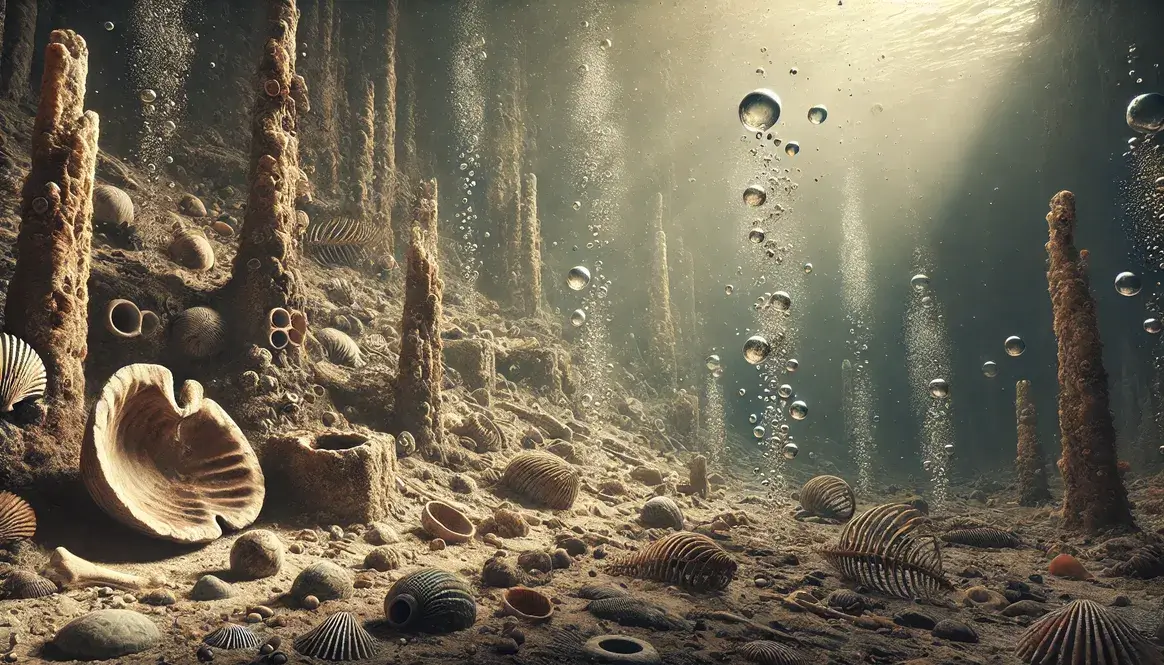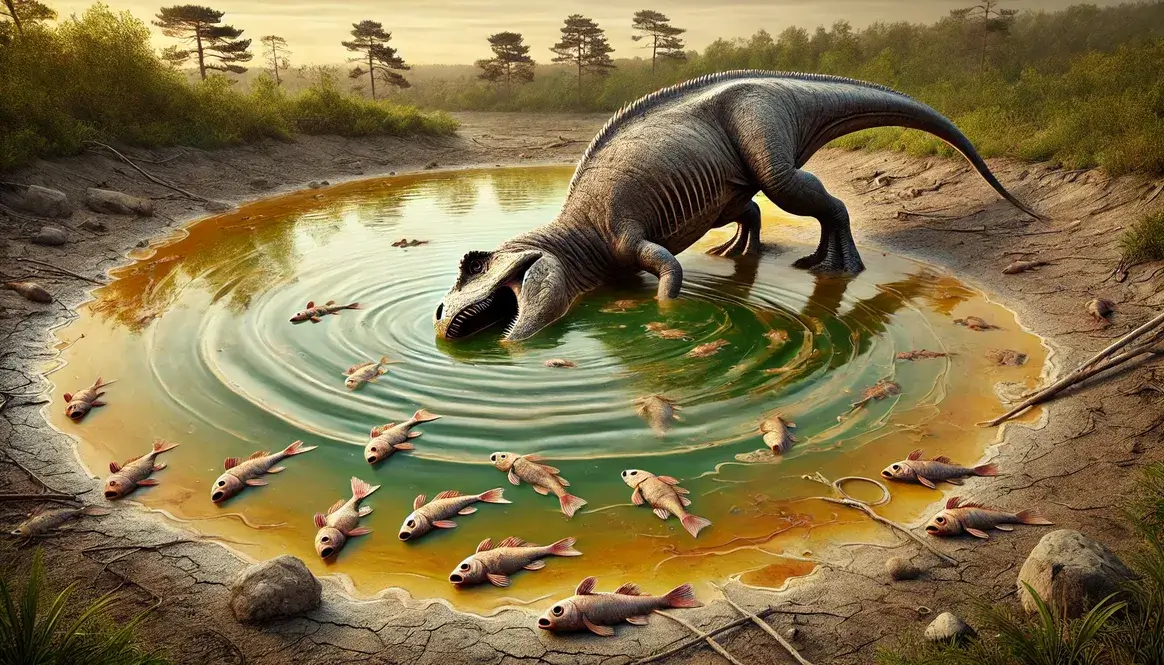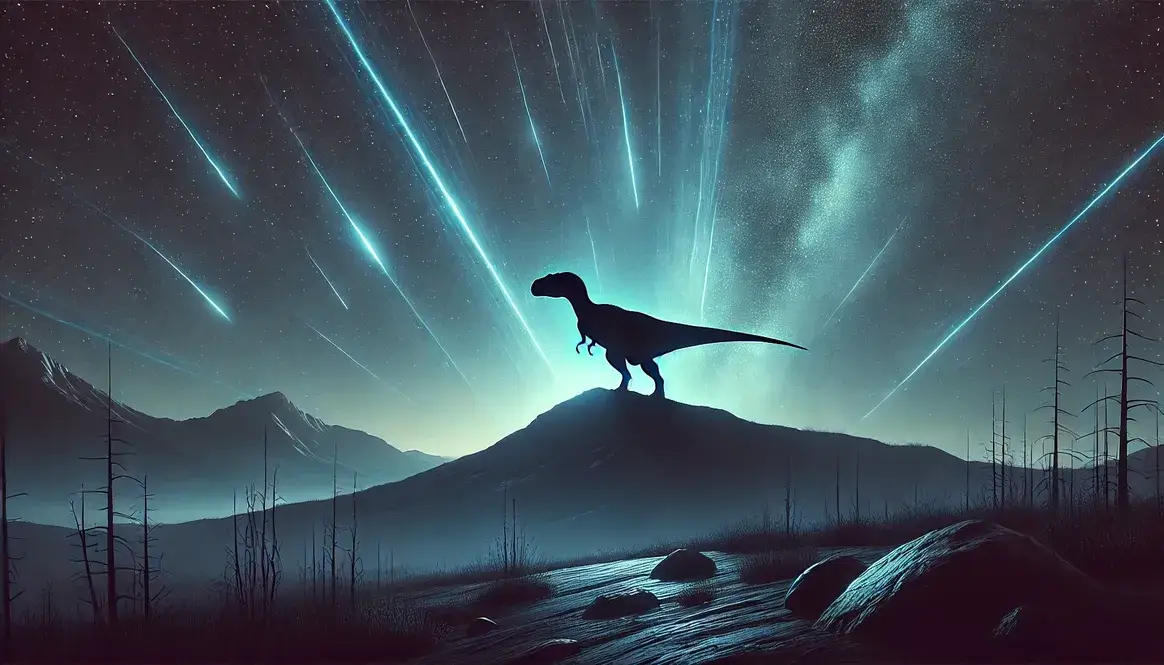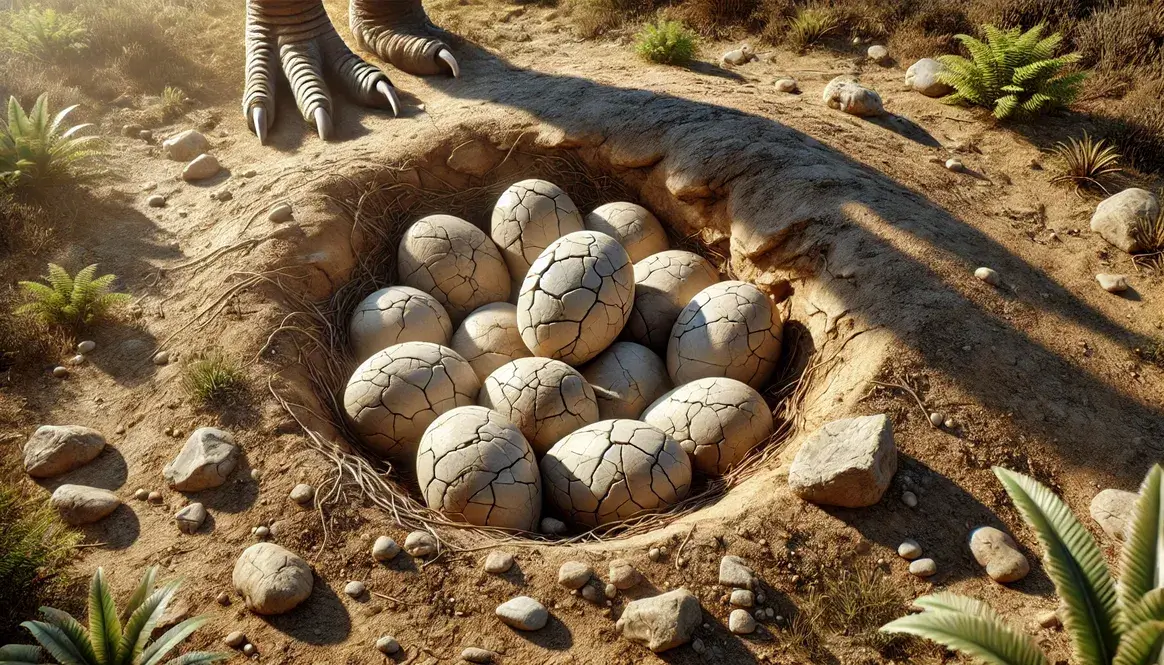The story of methane and dinosaur extinction reveals how a simple gas played a part in one of Earth’s most dramatic events. Scientists have found evidence that massive releases of methane into the atmosphere may have made the end-Cretaceous extinction even worse than previously thought.
| Key Facts About Methane and Dinosaur Extinction | Impact |
|---|---|
| Temperature Increase | 5-8°C global warming |
| Methane Source | Ocean floors and wetlands |
| Time Period | Late Cretaceous Period |
| Effect on Climate | Intensified greenhouse effect |
| Ocean Impact | Increased acidification |
Methane and Dinosaur Extinction: The Connection
Methane is a powerful gas that traps heat in Earth’s atmosphere. Think of it like a blanket – the thicker the blanket of methane in the sky, the warmer Earth becomes. During the time of the dinosaurs, methane existed in small amounts that kept Earth at comfortable temperatures.
But something changed. Scientists studying rocks from the end of the Cretaceous Period have found signs that huge amounts of methane suddenly entered the atmosphere. This methane came from two main places:
- Ocean floors, where it was frozen in ice-like crystals
- Land areas, especially wet swamps and marshes
When methane enters the atmosphere, it creates a strong greenhouse effect. In fact, methane traps heat 25 times more effectively than carbon dioxide. Scientists have found evidence of this heating in rocks from the extinction period:
| Evidence Type | What It Shows |
|---|---|
| Carbon Isotopes | Sudden spike in methane levels |
| Ocean Sediments | Changes in water chemistry |
| Plant Fossils | Signs of heat stress |
| Rock Layers | Rapid climate change markers |
The initial evidence linking methane to the dinosaur extinction comes from tiny bubbles trapped in rocks. These bubbles contain samples of ancient air, showing that methane levels rose significantly during the extinction event. This increase matched other signs of environmental stress found in the K-Pg extinction.
Scientists studying the Cretaceous climate have found that this methane release might have:
- Raised global temperatures rapidly
- Made oceans more acidic
- Changed weather patterns worldwide
- Affected plant growth and food supplies
This methane release didn’t act alone in causing extinctions, but it made a bad situation worse by adding extra stress to already struggling ecosystems.
Where Did the Methane Come From?
Scientists have discovered that methane came from multiple sources during the end of the Cretaceous period. These sources worked together to release large amounts of this powerful greenhouse gas into the atmosphere.
Marine Methane Sources
The oceans held massive amounts of frozen methane in their depths. These deposits, called methane hydrates, looked like ice but contained trapped methane gas. When the Late Cretaceous climate changed, these frozen deposits began to melt.
Several events could trigger methane release from the oceans:
- Warming ocean temperatures
- Earthquakes and underwater landslides
- Changes in ocean currents
- Shifts in water pressure
| Ocean Depth | Amount of Methane Stored |
|---|---|
| Shallow (0-200m) | Small amounts |
| Mid-depth (200-1000m) | Moderate amounts |
| Deep (>1000m) | Large deposits |
Scientists studying marine ecosystem collapse have found clear signs of methane release in ocean rocks. These rocks show bubbles where gas escaped and changes in the types of minerals that formed.
Land-Based Methane Sources
On land, methane came from three main places: wetlands, volcanoes, and dying plants. Each source added its own share of methane to the air.
The Deccan Traps volcanoes released methane directly from Earth’s interior. But the biggest land source was likely wetlands, where dead plants rotted underwater. This process still creates methane today in swamps and marshes.
Dead and dying plants also released methane as they decomposed. When plants began dying from environmental stress, they created a cycle:
- Plants died from heat and acid rain
- Dead plants released methane as they rotted
- More methane led to more warming
- More plants died as a result
The evidence for land-based methane comes from:
- Changes in soil chemistry
- Plant fossil patterns
- Carbon traces in rocks
- Wetland sediment layers
This combination of ocean and land sources created what scientists call a “methane pulse” – a sudden increase in atmospheric methane that contributed to rapid global warming.## How Methane Changed Earth’s Systems
The release of methane transformed Earth’s systems in ways that made life harder for many species. These changes happened quickly, giving animals and plants little time to adapt.
Atmosphere Changes
The atmosphere experienced the first and most direct effects of increased methane. As methane entered the air, it started a chain of events that changed Earth’s climate. The Cretaceous carbon cycle shows how methane interacted with other gases to create dramatic changes.
| Temperature Effects | Impact on Life |
|---|---|
| Global rise of 5-8°C | Heat stress on animals |
| Polar regions warmed most | Loss of cold-adapted species |
| Ocean surface warming | Marine food chain disruption |
| Increased evaporation | Changed rainfall patterns |
Methane didn’t work alone. It mixed with other greenhouse gases, making their effects stronger. Scientists studying extreme weather events have found evidence of:
- More powerful storms
- Longer droughts
- Unusual rainfall patterns
- Temperature swings
The warming atmosphere changed wind patterns too. This affected:
- Where rain fell
- How clouds formed
- Ocean current movements
- Weather stability
The atmosphere became less friendly to life with each passing year. Cretaceous polar dinosaurs faced special challenges as their once-cool homes became much warmer. Even areas that stayed warm year-round became too hot for many species.
Scientists know these changes happened because they’ve found clues in rocks that formed during this time. These rocks show signs of rapid heating, changed rain patterns, and unusual weather events that match what we’d expect from a methane-warmed world.
Ocean Changes
When methane dissolved in seawater, it changed the ocean’s chemistry. The water became more acidic, making it harder for animals with shells to survive. Ocean circulation changes brought warm water to new areas, disrupting marine ecosystems worldwide.
The effects on ocean life were severe:
| Ocean Change | Effect on Marine Life |
|---|---|
| Higher acidity | Shell formation problems |
| Warmer water | Less dissolved oxygen |
| Changed currents | Disrupted food supplies |
| Altered chemistry | Stressed marine animals |
Marine animals struggled as their environment changed. Freshwater ecosystems near the coast faced unique challenges when salt water mixed with fresh water in new ways.
Land Changes
On land, plants faced their own set of problems. As soil chemistry changed, many plants couldn’t get the nutrients they needed. This started a chain reaction through the food web, affecting plant-eating dinosaurs first and then their predators.
The changes in plant life happened in several ways:
- Acid rain changed soil chemistry
- Higher temperatures stressed plants
- Changed rainfall patterns affected growth
- New weather patterns disrupted growing seasons
Ecological cascade effects spread through land environments as plant communities changed. When plants struggled, plant-eating dinosaurs had less food. This meant less food for meat-eating dinosaurs too.
Scientists studying soil from this time have found:
- Changes in mineral content
- Signs of increased erosion
- Different types of plant remains
- Evidence of stressed ecosystems
These changes in both oceans and land created what scientists call a “negative feedback loop” – where each change made other problems worse. The more methane was released, the more Earth’s systems changed, leading to even more methane release from various sources.
Evidence in the Rock Record
The rocks that formed during the extinction period tell us how methane affected Earth’s systems. These rocks contain both chemical and physical signs that help scientists understand what happened.
Chemical Signatures
Scientists have found clear chemical signs of methane release in rocks worldwide. These signs appear in a special layer of rock called the K-Pg boundary, which marks the end of the dinosaur age.
Chemical evidence includes:
| Type of Evidence | What It Reveals |
|---|---|
| Carbon isotopes | Sudden methane increase |
| Sulfur traces | Ocean chemistry changes |
| Mercury levels | Volcanic gas releases |
| Oxygen markers | Atmospheric changes |
Scientists studying volcanic fossil evidence have found that methane markers appear in rocks from all continents. This shows that the methane release affected the entire planet.
Physical Evidence
The physical signs of methane release and climate change appear in many forms. Rock layers from this time show unusual patterns that tell us about rapid environmental changes.
Sediments laid down during this time contain:
- Unusual mineral formations
- Disrupted layer patterns
- Evidence of rapid erosion
- Signs of ocean chemistry changes
Heavy metal traces in these rocks also give us clues about environmental stress. These metals, combined with methane effects, made survival even harder for many species.
Physical evidence shows up most clearly in:
- Ocean floor sediments
- Coastal rock formations
- Lake bed deposits
- Ancient soil layers
Each piece of evidence adds to our understanding of how methane contributed to the extinction event. By studying both chemical and physical signs in rocks, scientists can piece together the story of Earth’s changing climate during this critical time.
Combined Effects with Other Factors
Methane release didn’t act alone in causing the extinction of the dinosaurs. Instead, it worked together with other environmental stresses to create especially difficult conditions for life on Earth.
The Chicxulub impact physics show that when the asteroid hit Earth, it released huge amounts of heat and energy. This impact could have triggered additional methane release by:
- Shaking methane loose from ocean floors
- Starting widespread fires
- Disturbing ocean waters
- Releasing trapped gases from rocks
| Environmental Factor | How It Worked with Methane |
|---|---|
| Asteroid impact | Released more trapped methane |
| Volcanic eruptions | Added extra greenhouse gases |
| Ocean changes | Released seafloor methane |
| Forest fires | Added more carbon to the air |
The Deccan Traps models suggest that volcanic activity played a big part too. Volcanoes added their own gases to the atmosphere, making the methane’s warming effects even stronger.
Scientists studying rate of climate change at the end of the Cretaceous period found that these combined factors created what they call “multiple stressors.” This means that plants and animals faced many problems at once:
- Higher temperatures from methane
- Acid rain from volcanoes
- Darkness from impact dust
- Changed rainfall patterns
- Ocean acidification
When all these factors worked together, they created conditions that were too extreme for many species to survive. Even species that might have survived one or two changes had trouble when faced with all of them at once.
What This Tells Us About Past and Present
The story of methane and dinosaur extinction offers important lessons for today. Scientists studying climate change velocity have noticed similarities between past and present methane releases.
Modern methane concerns include:
| Source | Modern vs. Past |
|---|---|
| Permafrost melting | Similar to ancient methane hydrates |
| Wetland changes | Like Cretaceous wetland releases |
| Human activities | New source not present in past |
| Ocean warming | Similar to ancient ocean releases |
Today’s scientists use knowledge from the past to understand possible future changes. The volcanic evolutionary impact shows how Earth’s systems can change quickly when pushed too far.
Key lessons learned:
- Small changes can have big effects
- Multiple environmental stresses make survival harder
- Ocean chemistry changes can happen fast
- Some species adapt better than others
Scientists continue finding new evidence about how methane affected life during the extinction event. This helps them better understand both past extinctions and current environmental changes.
Looking Back to Move Forward
The end of the dinosaurs teaches us that Earth’s climate can change in powerful ways. While today’s changes differ from those of the past, the basic science stays the same. Methane remains an important part of Earth’s systems, capable of creating big changes in a short time.
What happened to the dinosaurs reminds us that even small changes in Earth’s chemistry can add up to make big differences in how friendly our planet is to life. By studying these ancient events, we learn valuable lessons about protecting Earth’s environment today.









